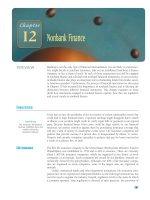Money banking and the financial system 1e by hubbard and OBrien chapter 18
Bạn đang xem bản rút gọn của tài liệu. Xem và tải ngay bản đầy đủ của tài liệu tại đây (2.31 MB, 58 trang )
R. GLENN
HUBBARD
ANTHONY PATRICK
O’BRIEN
Money,
Banking, and
the Financial
System
© 2012 Pearson Education, Inc. Publishing as Prentice Hall
CHAPTER
18
Monetary Theory II:
The IS–MP Model
LEARNING OBJECTIVES
After studying this chapter, you should be able to:
18.1
Understand what the IS curve is and how it is derived
18.2
Explain the significance of the MP curve and the Phillips curve
18.3
Use the IS–MP model to illustrate macroeconomic equilibrium
18.4
Discuss alternative channels of monetary policy
18A
Use the IS-LM model to illustrate macroeconomic equilibrium
© 2012 Pearson Education, Inc. Publishing as Prentice Hall
CHAPTER
18
Monetary Theory II:
The IS–MP Model
THE FED FORECASTS THE ECONOMY
•In July 2010, the Federal Reserve lowered its forecasts for economic growth.
The Fed cited continued weakness in the housing market, a slow recovery in the
labor market, and less than favorable financial conditions for growth.
•The Bank of England and the French government also reduced their forecasts
for the growth of real GDP in 2010 and 2011.
•Having some idea of the likely state of the economy in the future helps to guide
policy today. In preparing its forecasts, the Fed, foreign central banks, and private
forecasters usually rely on macroeconomic models.
•AN INSIDE LOOK AT POLICY on page 574 discusses four policy options the
Federal Reserve was considering in late 2010 to provide additional stimulus to
the U.S. economy.
© 2012 Pearson Education, Inc. Publishing as Prentice Hall
Key Issue and Question
Issue: By December 2008, the Fed had driven the target for the federal
funds rate to near zero.
Question: In what circumstances is lowering the target for the federal
funds rate unlikely to be effective in fighting a recession?
© 2012 Pearson Education, Inc. Publishing as Prentice Hall
4 of 58
18.1Learning Objective
Understand what the IS curve is and how it is derived.
© 2012 Pearson Education, Inc. Publishing as Prentice Hall
5 of 58
IS–MP model A macroeconomic model consisting of an IS curve, which
represents equilibrium in the goods market; an MP curve, which represents
monetary policy; and a Phillips curve, which represents the short-run
relationship between the output gap (which is the percentage difference
between actual and potential real GDP) and the inflation rate.
IS curve A curve in the IS–MP model that shows the combinations of the real
interest rate and aggregate output that represent equilibrium in the market for
goods and services.
MP curve A curve in the IS–MP model that represents Federal Reserve
monetary policy.
Phillips curve A curve showing the short-run relationship between the output
gap (or the unemployment rate) and the inflation rate.
The IS Curve
© 2012 Pearson Education, Inc. Publishing as Prentice Hall
6 of 58
Equilibrium in the Goods Market
Table 18.1
The Relationship Between Aggregate Expenditure and GDP
The IS Curve
© 2012 Pearson Education, Inc. Publishing as Prentice Hall
7 of 58
The IS Curve
© 2012 Pearson Education, Inc. Publishing as Prentice Hall
8 of 58
Figure 18.1 (1 of 2)
Illustrating Equilibrium
in the Goods Market
Panel (a) shows that equilibrium in
the goods market occurs at output
level Y1,where the AE line crosses
the 45° line.
The IS Curve
© 2012 Pearson Education, Inc. Publishing as Prentice Hall
9 of 58
Figure 18.1 (2 of 2)
Illustrating Equilibrium
in the Goods Market
In panel (b), if the level of output is
initially Y2, aggregate expenditure
is only AE2.
Rising inventories cause firms to
cut production, and the economy
will move down the AE line until it
reaches equilibrium at output level
Y1.
If the output level is initially Y3,
aggregate expenditure is AE3.
Falling inventories cause firms to
increase production, and the
economy will move up the AE line
until it reaches equilibrium at
output level Y1.•
The IS Curve
© 2012 Pearson Education, Inc. Publishing as Prentice Hall
10 of 58
Potential GDP and the Multiplier Effect
Potential GDP The level of real GDP attained when all firms are producing at
capacity.
At potential GDP, the economy achieves full employment, and cyclical
unemployment is reduced to zero. So, potential GDP is sometimes called fullemployment GDP.
In the context of this basic macroeconomic model, autonomous expenditure is
expenditure that does not depend on the level of GDP.
A decline in autonomous expenditure results in an equivalent decline in income,
which leads to an induced decline in consumption.
Multiplier effect The process by which a change in autonomous expenditure
leads to a larger change in equilibrium GDP.
Multiplier The change in equilibrium GDP divided by a change in autonomous
expenditure.
The IS Curve
© 2012 Pearson Education, Inc. Publishing as Prentice Hall
11 of 58
The IS Curve
© 2012 Pearson Education, Inc. Publishing as Prentice Hall
12 of 58
Figure 18.2
The Multiplier Effect
The economy is initially in
equilibrium at potential
GDP,YP, and then the
investment component, I, of
aggregate expenditure falls.
As a result, the aggregate
expenditure line shifts from
AE1 to AE2.
The economy moves down
the AE line to a new
equilibrium level of
output,Y2.The decline in
output is greater than the
decline in investment
spending that caused it.
The IS Curve
© 2012 Pearson Education, Inc. Publishing as Prentice Hall
13 of 58
Solved Problem
18.1
Calculating Equilibrium Real GDP
The IS Curve
© 2012 Pearson Education, Inc. Publishing as Prentice Hall
14 of 58
Solved Problem
18.1
Calculating Equilibrium Real GDP
The IS Curve
© 2012 Pearson Education, Inc. Publishing as Prentice Hall
15 of 58
The IS Curve
© 2012 Pearson Education, Inc. Publishing as Prentice Hall
16 of 58
Constructing the IS Curve
The focus of Fed policy is establishing a target for the federal funds rate, with
the expectation that changes in the federal funds rate will cause changes in
other market interest rates. Therefore, we need to incorporate the effect of
changes in interest rates into our model of the goods market.
The real interest rate equals the nominal interest rate minus the expected
inflation rate. An increase in the real interest rate causes I and C to decline.
A higher domestic real interest rate also makes returns on domestic financial
assets more attractive relative to those on foreign assets, raising the exchange
rate. The rise in the exchange rate increases imports and reduces exports,
thereby reducing NX.
A decrease in the real interest rate will have the opposite effect—increasing I,
C, and NX.
So, a higher interest rate causes a reduction in aggregate expenditure and a
lower equilibrium level of output.
The IS Curve
© 2012 Pearson Education, Inc. Publishing as Prentice Hall
17 of 58
Figure 18.3
Deriving the IS Curve
Panel (a) uses the 45°-line diagram to show the effect of changes in the real interest rate
on equilibrium in the goods market. With the real interest rate initially at r1, the aggregate
expenditure line is AE(r1), and the equilibrium level of output is Y1 (point A).
If the interest rate falls from r1 to r2, the aggregate expenditure line shifts upward from
AE(r1) to AE(r2), and the equilibrium level of output increases from Y1 to Y2 (point B).
If the interest rate rises from r1 to r3, the aggregate expenditure line shifts downward from
AE(r1) to AE(r2), and the equilibrium level of output falls from Y1 to Y3 (point C).
In panel (b),we plot the points from panel (a) to form the IS curve. The points A, B, and C
© 2012 Pearson
Education,
Publishing as Prentice
in panel
(b)Inc.correspond
to Hall
the points A, B, and C in panel (a).•
18 of 58
The Output Gap
With the Taylor rule (Chapter 15), the Fed has a target for the real federal funds
rate and adjusts that target on the basis of changes in two variables: the
inflation gap and the output gap. The inflation gap is the difference between the
current inflation rate and a target rate.
Output gap The percentage difference between real GDP and potential GDP.
Figure 18.4
Output Gap
The output gap is
negative during
recessions
because real GDP
is below potential
GDP.•
The IS Curve
© 2012 Pearson Education, Inc. Publishing as Prentice Hall
19 of 58
Figure 18.5
The IS Curve Using the
Output Gap
This graph shows the IS curve with the
output gap, rather than the level of real
GDP, on the horizontal axis.
Values to the left of zero on the horizontal
axis represent negative values for the
output gap—or periods of recession—
and values to the right of zero on the
horizontal axis represent positive values for
the output gap—periods of expansion.
The vertical line, Y = YP, is also the point
where the output gap is zero.
The IS Curve
© 2012 Pearson Education, Inc. Publishing as Prentice Hall
20 of 58
Shifts of the IS Curve
An increase or a decrease in the real interest rate results in a movement along
the IS curve. Changing other factors that affect aggregate expenditure will
cause a shift of the IS curve.
Aggregate demand shock A change in one of the components of aggregate
expenditure that causes the IS curve to shift.
Figure 18.6
Shifts in the IS Curve
For any given level of the real
interest rate, positive demand
shocks shift the IS curve to the right
and negative demand shocks shift
the IS curve to the left.•
The IS Curve
© 2012 Pearson Education, Inc. Publishing as Prentice Hall
21 of 58
18.2Learning Objective
Explain the significance of the MP curve and the Phillips curve.
© 2012 Pearson Education, Inc. Publishing as Prentice Hall
22 of 58
The Taylor rule tells us that when the inflation rate rises above the Fed’s target
inflation rate of about 2%, the FOMC will raise its target for the federal funds
rate. And when the output gap is negative—that is, when real GDP is less than
potential GDP, the FOMC will lower the target for the federal funds rate.
The MP Curve and the Phillips Curve
© 2012 Pearson Education, Inc. Publishing as Prentice Hall
23 of 58
The MP Curve
Figure 18.7
The MP Curve
The MP Curve and the Phillips Curve
© 2012 Pearson Education, Inc. Publishing as Prentice Hall
24 of 58
The Phillips Curve
The Fed relies on an inverse relationship between the inflation rate and the
state of the economy: When output and employment are increasing, the
inflation rate tends to increase, and when output and employment are
decreasing, the inflation rate tends to decrease.
A graph showing the short-run relationship between the unemployment rate
and the inflation rate has been called a Phillips curve. The position of the
Phillips curve can shift over time in response to supply shocks and changes in
expectations of the inflation rate.
The best way to capture the effect of changes in the unemployment rate on the
inflation rate is by looking at the gap between the current unemployment rate
and the unemployment rate when the economy is at full employment, which is
called the natural rate of unemployment. The gap between the current rate of
unemployment and the natural rate represents cyclical unemployment.
The MP Curve and the Phillips Curve
© 2012 Pearson Education, Inc. Publishing as Prentice Hall
25 of 58









